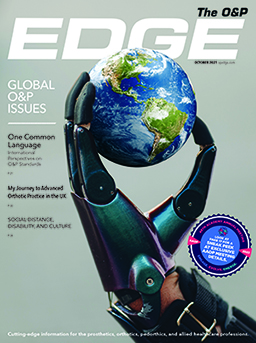Study Shows Management of Serious Diabetic Foot Ulcers Was Possible During the COVID-19 Lockdown
September 29, 2021
New research reveals how Belgium's efforts to maintain a diabetic foot care program during the COVID-19 pandemic can offer valuable lessons to the rest of the world.
"Thanks to the great efforts of diabetic foot clinics, continued availability of diabetic foot ulcer services during lockdown, although in a limited capacity, were really helpful, and may be the reason why we didn't see late presentation and the impact on the severity of ulcers was limited to slightly larger wounds", said lead author An-Sofie Vanherwegen, PhD, from Sciensano, Brussels, Belgium. "Our findings will hopefully guide diabetic foot clinics in serving their patients using innovative strategies, such as telemedicine, during the current, and eventual future, public health crises."
It is estimated that around a quarter of all people living with diabetes worldwide will develop a foot ulcer in their lifetime. Without timely treatment, these ulcers are hard to heal and form the leading cause of lower-limb amputations in Western countries.
In 2005, a national diabetic foot care program (IQED-Foot) was established in Belgium that has resulted in 34 multidisciplinary diabetic foot clinics recognized by the Belgian Ministry of Health for the treatment of diabetic ulcers. Since then, a clear decline in the lower-limb amputation rate has been noted in the country.
"As the COVID-19 pandemic unfolded, there were concerns about the impact on Belgians with diabetic foot ulcers. People need to be seen quickly if an ulcer begins to form—that gives diabetic foot clinics the greatest chance of treating the wound successfully," said Vanherwegen.
A national lockdown in Belgium between March 14 and May 3, 2020, placed restrictions on free movement and only urgent care was provided in hospitals. However, diabetic foot clinics were advised by professional associations to consider all active diabetic foot problems as urgent.
To gauge the impact of the pandemic on the presentation rate and severity of diabetic foot ulcers in these clinics, researchers distributed a survey to the recognized clinics across Belgium asking about the measures they had taken during and after the lockdown to maintain their activities. A total of 24 clinics participated in the survey.
During the lockdown, one clinic closed, but the 23 others remained open for urgent care, applying COVID-19 measures—almost three-quarters (71 percent) of clinics selected patients based on urgency and high risk for ulceration, 79 percent reported partially switching to remote consultations,13 clinics (54 percent) reduced the frequency of consultations for patients, and half spread out patient appointments during the day to allow for physical distancing.
Between January 1 and September 30, 2020, patient and ulcer characteristics were recorded by 22 foot clinics for 887 consecutive patients presenting with new moderate to severe diabetic foot ulcers. Patients were assigned to three groups based on the date of first contact with the clinic—pre-lockdown (322 patients), during lockdown (93), and post-lockdown (472)—and compared to data from the same time period of the IQED-Foot data collection in 2018. No differences in patient characteristics (e.g., age, gender, medical history, diabetes type, and duration) were noted between the groups.
The study found that compared to the same time period in 2018, the average weekly presentation rate of patients during lockdown was substantially reduced (by almost 60 percent-from 1.4 patients per week in 2018 to 0.6 patients per week in lockdown). However, there was no change in average patient-reported delay in presentation, although patients during and after lockdown tended to present with slightly larger ulcers. No significant differences in depth, infection, or loss of protective sensation were detected between the three groups.
The authors recognize several limitations of study, including that no data on mild foot ulcers was collected, however, these tend to have a much better prognosis. In addition, no information was available on people with a foot ulcer who were unable to present to a recognized diabetic foot clinic.
The study was presented this week at the 2021 European Association for the Study of Diabetes meeting.






-
-
-
-
CONTACT US